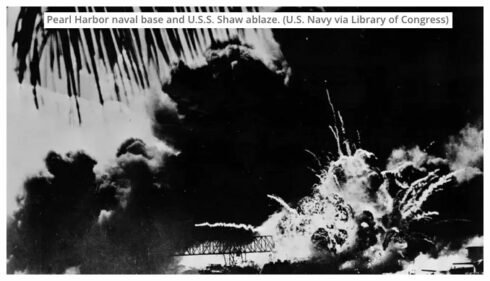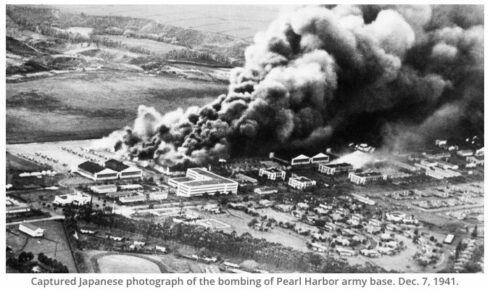Remembering the attack on Pearl Harbor 81 years ago
Posted By RichC on December 7, 2022
It feels uncomfortably routine, to nonchalantly include a remembrance post on December 7th each year … but it is important to reflect on the evil of man and human devastation associated with war. In remembering the loss of American lives inflicted by the Japanese in their “unprovoked and dastardly” attack of Pearl Harbor, I’ll include a very brief history and timeline below.
In remembering 2400 Americans who lost their lives that day in 1941, it is important to follow the events that lead to Japan deciding to go to war with … as Isoroku Yamamoto put it … “a sleeping giant.” The timeline preceding attacking the U.S. may have a bit to do with Japan being closed society for so many centuries or just the ambitions of egotistical and power hungry humans. Take a look at history. Japan’s lack of resources required that they colonize to support their growth and technological advancement … and perhaps in their eyes of their leaders … to protect their growing population.
By the end of the 1930s, Japanese ambition was clear … and with the western world focused on Germany , the Nazis and Hitler … European colonial powers were clearly preoccupied with what would be another World War. By 1940, the U.S. made an attempt to thwart Japanese expansion by imposing trade sanctions and then an oil embargo on oil in order to stop their military expansion in Asia (Japan had invaded North China in 1937). By 1941, Japanese officers started discussing a possible attack on Pearl Harbor.
Timeline in for the year of 1941 (FoxLA.com):
Nov. 16: Japanese submarines depart for Pearl Harbor in preparation of a possible attack.
Nov. 26: A final attempt at diplomacy on the part of the Japanese is rejected by President Franklin D. Roosevelt. Japanese aircraft carriers and escorts depart for Pearl Harbor in response.
Nov. 27: President Franklin D. Roosevelt issues a war warning for the Pacific, which is largely ignored in Hawaii.
Dec. 6: U.S. intelligence decodes a crucial message pointing to the next morning as a deadline for an undetermined Japanese action. The message is delivered to Washington’s high command more than four hours ahead of the attack on Pearl Harbor, but the message is not forwarded to U.S. commanders in Honolulu.
Dec. 7, 7:02 a.m. local time: Two U.S. radar operators identify large groups of aircraft in flight toward the island of Oahu from the north. Because they were expecting a flight of B-17s from the U.S. at any moment, they do not sound an alarm.
Dec. 7, 7:55 a.m. local time: A swarm of Japanese warplanes descends on Honolulu, attacking ships in Pearl Harbor, as well as air stations at Hickam, Wheeler, Ford Island, Kaneohe and Ewa Field. The attack lasts for two hours and 20 minutes.
When the attack is finally over, 18 ships and more than 300 aircraft have been destroyed or damaged. More than 2,400 Americans were killed, and an additional 1,200 wounded.
Dec. 8: President Roosevelt addresses Congress, and his address is broadcast via radio to the American public. Roosevelt asks Congress for a declaration of war against Japan, which Congress approves.


Comments